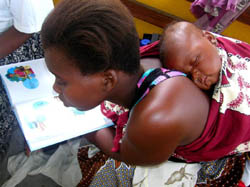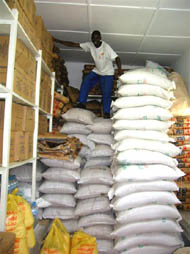The DREAM Approach

DREAM is first and foremost a different approach to Africa. It is an injection of faith and hope, and, we could say, a contagion of faith and hope.
We have faith and hope that AIDS can be fought in Africa. We also have faith and hope that the living conditions of many HIV-positive people, marked by stigma, by the fear of speaking out, by a sense of condemnation, can be changed. Faith and hope that men and women tried and weakened by the disease can, so to speak, “resurrect” themselves, regaining energy for themselves and for others. And we have faith and hope that millions of children – the future of Africa, but also of our planet – can have, ahead of them, the long life that we would want our own sons and daughters to have the right to.
DREAM reflects the way of thinking of Sant’Egidio.
For this reason, the programme was born with the goal of promoting a combination of prevention and treatment, in the firm conviction that it is imperative to save as well as to preserve, to win more time for as many people as possible. DREAM was conceived to achieve excellence, excellence in treatment and diagnostics, in administration and computerization. DREAM demands western standards for Africa too, routinely using viral load assessment, and giving Highly Active Anti-Retroviral Therapy (HAART), the current golden standard in the treatment of HIV infection, to all patients who need it.

For the Community of Sant’Egidio, people are never simply “emergencies”, they always remain people. For this reason, we are prompted by that simple and ancient saying that suggests we do unto others as we would have others do unto us. And who would not want excellence for himself? This approach has profound validity. It gives great motivation to the staff involved, it gets the best in terms of patient collaboration, and it brings down dropout rates and interruption of treatment. Minimalism, so often proposed in terms of international aid and cooperation, risks dangerous, if not downright fatal, consequences in the struggle against AIDS, in an environment already exposed to too many shortcomings. The problem of resources exists, but the priority is to construct an assistance model that works.
The important thing, in any case, is that all health services offered – from diagnostics to nutritional support, to health education and conventional treatment of opportunistic infections – are offered completely free-of-charge. It is impossible to ask people who don’t even have enough money to buy food for themselves and their families, to pay for medicines. Nor is it an option to demand money from sick children, especially orphans. That treatment is free-of-charge is a must, and not only for reasons of fairness. The fact that treatment is free accounts for the very high rate of patients’ adherence to the DREAM programme (however they are also offered an important secondary support system, systematic nutritional supplements). The whole point is not to distance sick people but rather to attract them. In Africa, one of the most pressing problems to be overcome is the extreme difficulties people have in accessing access health centres. The DREAM model requires extensive employment of personnel to overcome the chronic, endemic problem of difficulty of access to the national health service.
DREAM works precisely to ensure access to treatment, undertaking not only to welcome those who come to ask for care, and to give it freely, but also to seek out those patients who deem to be at risk of dropping out. For this reason, it was decided to train, in a serious and professional manner, not only strictly health personnel, but also many socio-health workers. The latter, once they have been inserted regularly into the programme, undertake more “mobile” functions, not only at the centre which is the base of the programme, but also in the surrounding area: Home care, monitoring administration of daily treatment and nutritional counselling to mothers are all tasks they undertake.
Access to treatment for all. DREAM has been modulated for rapid scaling-up. Excellence in services is the aim. And reduced economic resources have never imposed limits on the dream to extend treatment to a larger number of people and potentially to all. The ambition of DREAM is to extend its radius of action to an entire nation, and moreover, to become a model for all resource-limited countries.
The main problem remains the difficulty inherent in implementing the complex care required to treat HIV/AIDS infection in resource-limited health services, like those in Africa. Thus, it is necessary to forge an innovative path in this field, taking into account African peculiarities and the need for light, agile structures. There is no doubt that AIDS is a problem, a crisis, but, like all crises, it brings with it opportunity. An opportunity for a deep-rooted and radical renewal of African health services. Indeed, AIDS forces us to rethink how care in Africa could and must be. Often enough, this continent has been subjected to the planting of unsuccessful copies of western schemes, even if they did not have the same level of resources available, of funding, of personnel and of experience. DREAM is based on a flexible health model, which favours medical care for local residents, with small centres and the spread of services on a micro-scale level.
Adapted with permission from the DREAM website, February 2009.

- Comunità di Sant'Egidio
- Piazza S.Egidio 3a - 00153 - Roma, Italia
- Programma DREAM
- TEL: +39 06 8992225
- FAX: +39 06 89922525
- E-mail: dream@santegideo.org
- Website:dream.santegidio.org
- Website:www.santegidio.org